|
1
|
Hachinski V: World Stroke Day 2008:
‘Little strokes, big trouble’. Stroke. 39:2407–2420. 2008.
View Article : Google Scholar : PubMed/NCBI
|
|
2
|
Pantoni L: Cerebral small vessel disease:
From pathogenesis and clinical characteristics to therapeutic
challenges. Lancet Neurol. 9:689–701. 2010. View Article : Google Scholar : PubMed/NCBI
|
|
3
|
Amarenco P, Benavente O, Goldstein LB,
Callahan A, Sillesen H, Hennerici MG, Gilbert S, Rudolph AE,
Simunovic L, Zivin JA, et al: Stroke Prevention by Aggressive
Reduction in Cholesterol Levels Investigators: Results of the
stroke prevention by aggressive reduction in cholesterol levels
(SPARCL) trial by stroke subtypes. Stroke. 40:1405–1409. 2009.
View Article : Google Scholar : PubMed/NCBI
|
|
4
|
ten Dam VH, Van den Heuvel DM, van Buchem
MA, Westendorp RG, Bollen EL, Ford I, de Craen AJ and Blauw GJ;
PROSPER Study Group, : Effect of pravastatin on cerebral infarcts
and white matter lesions. Neurology. 64:1807–1809. 2005. View Article : Google Scholar : PubMed/NCBI
|
|
5
|
Mok VC, Lam WW, Fan YH, Wong A, Ng PW,
Tsoi TH, Yeung V and Wong KS: Effects of statins on the progression
of cerebral white matter lesion: Post hoc analysis of the ROCAS
(Regression of Cerebral Artery Stenosis) study. J Neurol.
256:750–757. 2009. View Article : Google Scholar : PubMed/NCBI
|
|
6
|
Fu JH, Mok V, Lam W, Wong A, Chu W, Xiong
Y, Ng PW, Tsoi TH, Yeung V and Wong KS: Effects of statins on
progression of subclinical brain infarct. Cerebrovasc Dis.
30:51–56. 2010. View Article : Google Scholar : PubMed/NCBI
|
|
7
|
Fu JH, Lu CZ, Hong Z, Dong Q, Luo Y and
Wong KS: Extent of white matter lesions is related to acute
subcortical infarcts and predicts further stroke risk in patients
with first ever ischaemic stroke. J Neurol Neurosurg Psychiatry.
76:793–796. 2005. View Article : Google Scholar : PubMed/NCBI
|
|
8
|
Fu JH, Wong K, Mok V, Hu X, Xiong Y, Chen
Y, Tang WK, Chen X, Wong A, Chu W, et al: Neuroimaging predictors
for depressive symptoms in cerebral small vessel disease. Int J
Geriatr Psychiatry. 25:1039–1043. 2010. View Article : Google Scholar : PubMed/NCBI
|
|
9
|
Jokinen H, Gouw AA, Madureira S, Ylikoski
R, van Straaten EC, van der Flier WM, Barkhof F, Scheltens P,
Fazekas F, Schmidt R, et al LADIS Study Group, : Incident lacunes
influence cognitive decline: The LADIS study. Neurology.
76:1872–1878. 2011. View Article : Google Scholar : PubMed/NCBI
|
|
10
|
van Dijk EJ, Prins ND, Vrooman HA, Hofman
A, Koudstaal PJ and Breteler MM: Progression of cerebral small
vessel disease in relation to risk factors and cognitive
consequences: Rotterdam Scan study. Stroke. 39:2712–2719. 2008.
View Article : Google Scholar : PubMed/NCBI
|
|
11
|
Greenberg SM: Small vessels, big problems.
N Engl J Med. 354:1451–1453. 2006. View Article : Google Scholar : PubMed/NCBI
|
|
12
|
Pantoni L, Basile AM, Pracucci G, Asplund
K, Bogousslavsky J, Chabriat H, Erkinjuntti T, Fazekas F, Ferro JM,
Hennerici M, et al: Impact of age-related cerebral white matter
changes on the transition to disability - The LADIS study:
Rationale, design and methodology. Neuroepidemiology. 24:51–62.
2005. View Article : Google Scholar : PubMed/NCBI
|
|
13
|
Pantoni L: Cerebral small vessel disease:
from pathogenesis and clinical characteristics to therapeutic
challenges. Lancet Neurol. 9:689–701. 2010. View Article : Google Scholar : PubMed/NCBI
|
|
14
|
Patel B and Markus HS: Magnetic resonance
imaging in cerebral small vessel disease and its use as a surrogate
disease marker. Int J Stroke. 6:47–59. 2011. View Article : Google Scholar : PubMed/NCBI
|
|
15
|
Fazekas F, Chawluk JB, Alavi A, Hurtig HI
and Zimmerman RA: MR signal abnormalities at 1.5 T in Alzheimers
dementia and normal aging. AJR Am J Roentgenol. 149:351–356. 1987.
View Article : Google Scholar : PubMed/NCBI
|
|
16
|
Shen H, Xu Y, Lu J, Ma C, Zhou Y, Li Q,
Chen X, Zhu A and Shen G: Small dense low-density lipoprotein
cholesterol was associated with future cardiovascular events in
chronic kidney disease patients. BMC Nephrol. 17:1432016.
View Article : Google Scholar : PubMed/NCBI
|
|
17
|
Annema W and von Eckardstein A:
Dysfunctional high-density lipoproteins in coronary heart disease:
Implications for diagnostics and therapy. Transl Res. 173:30–57.
2016. View Article : Google Scholar : PubMed/NCBI
|















